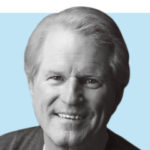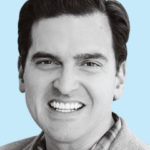David Allen’s whole career as a productivity and efficiency expert is based on being simple, direct, and action-oriented, and so his famous “work-life management system” for helping people get things done doesn’t mince words. It’s called Getting Things Done (GTD).
GTD is a practical, nuts-and-bolts program designed to overcome the chronic anxiety that often besets modern professionals — the feeling that whatever you’re doing now, there’s something else you should be doing, even if you’re not sure what it is or how to get started on it. “I’m not a psychiatrist or a psychologist, I’m just a practicing human being,” the wry, folksy Allen said in a recent interview. “But one way to think about this is, what I’ve done is uncover essentially the logistics of our head. In other words, if you keep track of would, could, should, ought to in your head — that part of you seems to have no sense of past or future. You could be as much reminded about it at three o’clock in the morning, when you can’t do anything about it, as any other time.”
As the founder and chairman of David Allen Company, a global training and consulting company, Allen developed GTD to help people “shut that voice up” — not necessarily by working on the project that’s keeping you up at night, but by systematically mapping out your commitments and responsibilities in a way that creates “some level of cruise control” in your mind. “I just uncovered or discovered or just made explicit the mechanics of what happens when you make commitments or have potentially meaningful stuff,” Allen said, “and you don’t appropriately engage with it.”
Not surprisingly, we found some relevance for meeting professionals — and their attendees.
It feels like nobody in history has ever been as busy or as overwhelmed by information and obligations as we are today. But is that actually true?
Well, I don’t know. How many more sonatas could Bach have written? How many more paintings could da Vinci have painted? There’s an openendedness to the amount of work that you could do. I don’t know if you’ve seen my TEDx talk I just did, but one of the conclusions I came up with when I really had to condense all of this is the fact that when you’re in crisis, there’s a kind of serenity that shows up, because [problems like] taxes and tires on your car are put on the backburner. You are trying to survive, right? You are totally focused on the desired results called “live” — don’t burn up, don’t drown, and don’t get killed. It demands appropriate engagement.
The problem is, when you’re not in crisis, you have a more subliminal crisis that shows up, because now the whole rest of the world floods into your head: “Oh, sh-t, now I’ve got taxes and I’ve got tires and I’m getting a cold, and my sister is about to divorce her husband and, oh, my God, they’re trying to borrow money from me” — all of that suddenly implodes in your psyche. Because we don’t have as many survival crises as a culture, we have another kind, which then creates that sort of subtle sense of more existential anxiety, that you should be doing a whole lot more different things or more stuff than whatever you’re currently doing, you just don’t know what the hell it is.
Is this a problem that’s driven by technology?
No, not at all. Technology makes it more obvious, because technology has allowed you to be able to search the Web about watercolor classes [for your kids]: “Oh, my God, there’s 43 of them out there. Now what am I doing?” So, the technology has made the opportunities a lot more ubiquitous and a lot more accessible and a lot more in your face.
While we were on this call, there’s stuff piling up on your desk and mine, too, that can totally blow the hell out of what we think we ought to be doing as soon as we get off this call. Those changes and those opportunities and those productivity-influencing, project-creating kinds of inputs — those always create some sort of dissonance out there. It’s just that they’re coming so fast. You and I have got more [information] in the last 72 hours than your parents got in a lifetime, in terms of stuff that could affect priorities and could create fairly significant change in terms of how you’re doing what you’re doing. You don’t have two years of cruise control once you get comfortable with a new job, or the change or the acquisition or the death in the family, or whatever. Now you’ve got about 20 minutes. And then something else is going to show up. So there is a new set of executive triage skills that, whereas 1 percent of 1 percent 40 years ago had to do it, now 50 percent of the workforce has to do it.
The late, great [management consultant] Peter Drucker framed it. He said, “Look, the biggest work for knowledge workers is to define what your work is.” It’s not already predefined; you have to do that. So, if you look on typical to-do lists, you’ll see things like “budget” or “bank” or “babysitter” or “Mom.” What are you going to do about those? What is your work about Mom and her birthday coming towards you? What is your work about the budget? Are you supposed to draft something? Input something? What? That’s where all the stress and the anxiety is. People have these commitments, but they don’t realize the thinking that’s required and the organization that’s required to be able to get that stuff to shut up in their head and to get back on to cruise control. That’s what I’ve figured out, is what that algorithm is.
Has your own approach to these questions changed or evolved as your company has grown and as your own professional responsibilities have increased?
It’s only been simplified. You know, it all sounds self-evident when we talk about it now. It wasn’t 20 years ago. It took me 25 years to figure out what I needed to figure out. It didn’t change it — it’s always been true. I mean, the principles I talk about are as old as dirt. You keep something in your head, it’s going to stress you and bankrupt your creative energy. You can’t fight that. That’s been true forever.
What’s changed is for me to understand better ways to explain it, to let the world know there’s a whole lot better place to operate from. It’s about understanding there are three primary principles, and if you understand them and how they function and operate, you can design your own systems and you can keep your head focused and clear.
Number one is, you’ve got to keep stuff out of your head and you’ve got to capture potentially meaningful stuff in trusted buckets. Write it down, stick it somewhere in your in-basket. Call your answering machine, leave yourself a message. Whatever you do, get it out of your head and get it out in front of you. And then, sooner than later, empty those buckets by going through each of those potentially meaningful things and decide, very specifically, what does it mean? What does “babysitter” mean? What does “Mom” mean? What does “budget” mean? What’s “bank” mean? And that means you’ve got to define outcomes desired and action steps required.
Step two is clarification of real, specific need. I know it needs something, but what specifically am I committed to about it, and how would I move forward on it? That’s what defining your work really is.
And stage three is to make sure you have appropriate maps of the results of all of that. You know, show me all the projects I’m getting ready to finish in the next 12 months. [If] you don’t have that, there’s no way you’re going to walk around with a clear head. Show me a map of all the things I have to do before noon tomorrow.
What is your map?
I use a good list manager. That’s probably the most basic map you can have. A calendar [in Outlook or other office software] is a list — it’s a chronological list. So there’s the calendar and all the stuff I need to do in and around the calendared stuff. And those are just action lists as well as a list of all the projects I’ve got. I [also] have a list of all the areas of accountability, in terms of my work and also my life. I have some of the bigger goals that I’m going toward. Those are all different kinds of maps that I have. But primarily, the most functional, operational ones are just good lists.
I use mind maps a good bit. I use MindManager [now Mindjet], which is a nice mind-mapping program on the computer. That’s got kind of a map of my maps. So the first thing I look at if I pull up a mind map is, okay, David, do you need to think about strategic projects? Do you need to think about big events coming toward you that you need to be planning for? Do you want to think about your job accountabilities? I’ve got a map that gives me that. It’s relatively crude, but it’s a whole lot better than what most people are working with.
It seems that a lot of this anxiety that people feel doesn’t necessarily come from what they have to do but rather from not knowing how or when to do it.
It’s common-sense stuff, but, yeah, you’re right. And most people have no clue how complex their life really is. I’ve spent thousands of hours sitting deskside with some of the best and brightest businesspeople on the planet, and they’re blown away by how many things they actually have their attention on, that they’re committed to. And almost nobody is even close to having appropriate maps. … You have to be willing to say, “I’ve got to get it out of my head. I’ve got to make some action and outcome decisions. And I really do need to build a trusted system that I keep current.” Otherwise my head starts to take that job, and then my creative energy is being used for something it doesn’t do very well.
All your event planners, they wouldn’t be in that business if they didn’t have some sort of a map that says, “Look, here are the events coming toward me — what’s my critical path there, what do I need to make sure happens. I’ve got the speaker there and we have audiovisual.” I would imagine that they all have some version of that. The truth is, though, the problem only comes when they’ve got more than one. How much do you orient yourself in terms of everything coming toward you on the horizon?
When people are actually attending a meeting, how should they be approaching GTD?
You are having experiences and you are getting input, so you deal with it how you deal with it. Generally speaking, you are probably going to have note-taking devices and you are going to be gathering all kinds of crap and schwag we are giving you in those kinds of things. At some point, you need to go back and throw that all in your in-basket and then clean it up within 24 to 48 hours after you get back from that meeting. Like, okay, which business cards actually mean something? What are you going to do about those notes? Are there any actions or projects that you can identify out of all that?
How can meeting planners help make meetings less overwhelming for their attendees?
Conferences usually have some rigor. People know why they are going to the conference, and the conference has some sort of theme. Of course, you can always get a lot more refined: “Well, this is a conference about neurology of right- and left-brain seizures.” Well, fabulous. What do you want out of this? You know, so there’s always going to be the individual relationship to whatever the designated purpose of the conference is.
Are there specific things that a planner can do to help alleviate the anxiety that attendees might feel from being away from the office?
Sure. Just make sure you have 30-minute breaks instead of 15, so they can check their voicemail and stuff like that. And just acknowledge that a lot of people are kind of out of control and all that stuff is banging on the head, and try to give them room to park all that. Like when I’m working with a client one on one — I’ve got a whole day or two days, and I’m going to be deskside with them — the first thing I ask them is, “What are you going to have to handle before I walk out of here today that doesn’t have anything to do with me?” We get that identified and I say, “Can we handle that right now?” and I just give them an hour. So that then they are present while I’m there, so they can utilize me for what they’re paying me big bucks to do.
I’m not quite sure how that would translate in terms of a conference, but the principle is there: “Hey, guys, we understand [you have responsibilities back at the office], so we’re going to give you a long break.” Maybe the first morning. I think that’d be a great thing to do.
Three Sure-Fire Productivity Tactics From David Allen
- Keep a notepad with you at all times. “The best ideas show up in the weirdest places. Not only that, you don’t know what the best ideas are. You just have ideas, and only over time will they emerge as good ones or bad ones. You have to have the raw data to begin with.”
- Make a decision. “A lot of people take notes, and then they just spread them all over God and creation and it doesn’t help either. You’ve got to process those so you can throw them away, but the only way you can throw them away is once you’ve gleaned what’s actual, what’s not, what’s referenced, what do I need to keep, what’s trash to get rid of. I know this sounds mundane, but it’s down in the mundaneness where the action really happens on this. As a matter of fact, if you don’t get the mundane, you’re screwed.”
- Conduct a weekly review. “You better have a one- to two-hour block [every week] where you are not answering emails over the phone and not dealing with anything else, but you’re actually stepping back and managing the forest instead of hugging the trees. Which basically means, get your maps current. Step back and take a look at the 45 projects you have, take a look at your calendar for the next two months, take a look at all the stuff you need to. Take a look at the right maps and orient yourself so that you’re not just driven by the latest and loudest. And that’s the biggest tactic and behavior that’s most lacking and most needed right now.”



